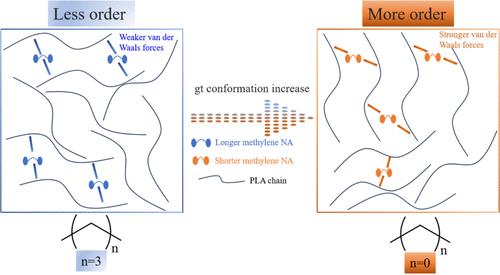基于分子间作用力控制聚乳酸构象,开发具有抗菌特性的高效生物基成核剂
IF 5.2
1区 化学
Q1 POLYMER SCIENCE
引用次数: 0
摘要
探索分子结构与构象之间的分子级相互作用机制以开发高效成核剂是一项令人感兴趣的工作。本研究中,我们合成了一系列亚甲基数目不同的吲哚酸衍生物有机金属盐生物基成核剂,用于制备聚乳酸和吲哚酸锌盐复合材料(PLA-IA-Zn)。结果表明,不含亚甲基链节的 3-吲哚羧酸锌盐(ICA-Zn)具有优异的成核活性。当添加量为 0.5 wt % 时,聚乳酸-ICA-锌的结晶峰值温度和结晶度分别提高到 117.5 ℃ 和 54.9%,而 135 ℃ 时的半结晶时间则缩短到 2.6 分钟。时间分辨傅立叶变换红外光谱和分子动力学结果表明,亚甲基连接的缺失显著提高了成核剂与熔融状态下聚乳酸之间的范德华能,促进了聚乳酸内部分子间和分子内的相互作用,增加了聚乳酸结晶过程中gt构象(对应于α型聚乳酸晶体的103螺旋构象)的含量,从而降低了成核障碍。抗菌结果表明,聚乳酸-α-锌复合材料对大肠杆菌的抑制率超过 93.2%,对金黄色葡萄球菌的抑制率超过 87.3%。这项研究从分子层面为设计兼具抗菌功能和高性能的高效成核剂分子提供了一种新策略。本文章由计算机程序翻译,如有差异,请以英文原文为准。

Developing an Efficient Biobased Nucleating Agent with Antimicrobial Properties by Controlling the Conformation of Poly(lactic acid) Based on Intermolecular Forces
Exploring the molecular-level interaction mechanisms between the molecular structure and conformation to develop efficient nucleating agents is an intriguing endeavor. In this study, we synthesized a series of indole acid derivative organic metal salt biobased nucleating agents with different numbers of methylene linkages for the preparation of PLA and zinc salts of indolic acid composite materials (PLA-IA-Zn). The results demonstrated that 3-indolecarboxylic acid zinc salt (ICA-Zn) without methylene linkages exhibited excellent nucleating activity. With an addition level of 0.5 wt %, PLA-ICA-Zn exhibited increased crystallization peak temperature and crystallinity to 117.5 °C and 54.9%, respectively, while the half-crystallization time was reduced to 2.6 min at 135 °C. Time-resolved Fourier transform infrared spectroscopy and molecular dynamics results demonstrate that the absence of methylene connectivity significantly enhances the van der Waals energy between the nucleating agent and PLA in the molten state, promoting intermolecular and intramolecular interactions within PLA, increasing the content of the gt conformation (corresponding to the 103 helical conformation of the α-type PLA crystal) during the PLA crystallization process, and thereby reducing the nucleation barrier. The antibacterial results showed that the PLA-IA-Zn composite materials achieved inhibition rates of over 93.2% for Escherichia coli and over 87.3% for Staphylococcus aureus. This study provides a new strategy at the molecular level for designing efficient nucleating agent molecules with both antibacterial functionality and high performance.
求助全文
通过发布文献求助,成功后即可免费获取论文全文。
去求助
来源期刊

Macromolecules
工程技术-高分子科学
CiteScore
9.30
自引率
16.40%
发文量
942
审稿时长
2 months
期刊介绍:
Macromolecules publishes original, fundamental, and impactful research on all aspects of polymer science. Topics of interest include synthesis (e.g., controlled polymerizations, polymerization catalysis, post polymerization modification, new monomer structures and polymer architectures, and polymerization mechanisms/kinetics analysis); phase behavior, thermodynamics, dynamic, and ordering/disordering phenomena (e.g., self-assembly, gelation, crystallization, solution/melt/solid-state characteristics); structure and properties (e.g., mechanical and rheological properties, surface/interfacial characteristics, electronic and transport properties); new state of the art characterization (e.g., spectroscopy, scattering, microscopy, rheology), simulation (e.g., Monte Carlo, molecular dynamics, multi-scale/coarse-grained modeling), and theoretical methods. Renewable/sustainable polymers, polymer networks, responsive polymers, electro-, magneto- and opto-active macromolecules, inorganic polymers, charge-transporting polymers (ion-containing, semiconducting, and conducting), nanostructured polymers, and polymer composites are also of interest. Typical papers published in Macromolecules showcase important and innovative concepts, experimental methods/observations, and theoretical/computational approaches that demonstrate a fundamental advance in the understanding of polymers.
 求助内容:
求助内容: 应助结果提醒方式:
应助结果提醒方式:


